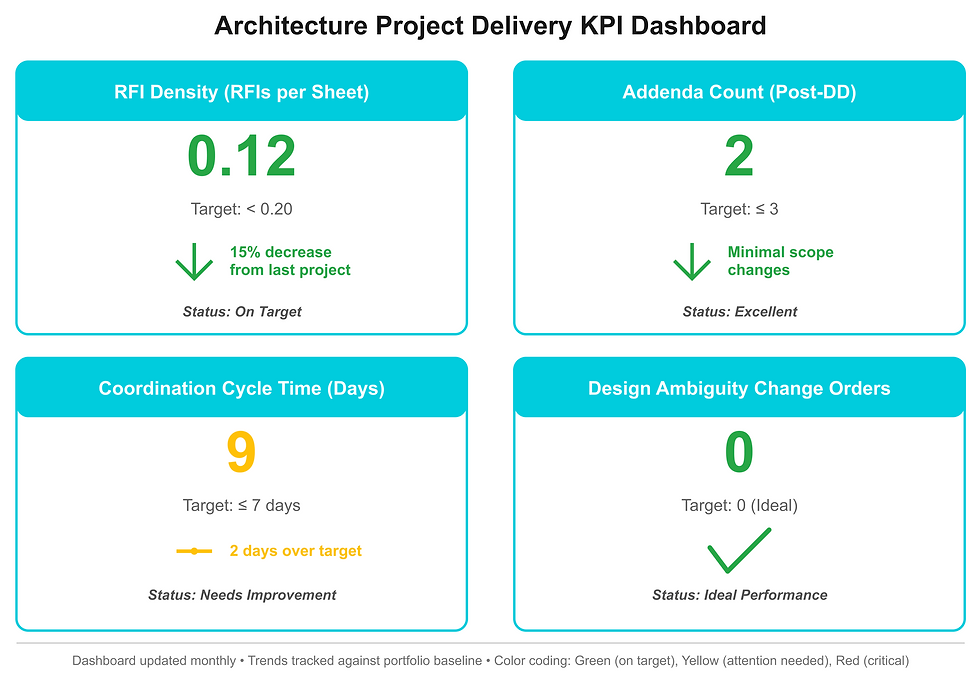Integrated Project Management and BIM for Architecture Firms: From Concept to Construction Without Surprise
- Andrew Haney

- Oct 30
- 3 min read
Project volatility, missed deadlines, budget drift, unexpected RFIs, and drawing-set inconsistencies - most often emerge at phase transitions and coordination boundaries. Below we’ll outline an integrated project management framework for architecture teams that links phase-gate discipline, BIM coordination, structured decision management, and measurable KPIs to produce more predictable outcomes from Schematic Design through Construction Administration.
The Variance Problem in Architectural Delivery
Project surprises rarely materialize “all at once.” They accumulate gradually through unclear scope, delayed decisions, and under-coordinated consultant documentation. Research and industry guidance from sources such as the AIA Best Practices (https://www.aia.org/resource-center/best-practices-enhancing-drawings-specifications) and DBIA Best Practices (https://dbia.org/) confirm that the root causes cluster into three categories:
Incomplete or unverified scope at phase milestones
Poorly coordinated consultant models and sheets
Decision latency from owners and stakeholder committees
Left unaddressed, these lead to downstream RFIs, costly ASIs, schedule slippage, and can cause mistrust between parties.

Figure 1 - Phase-Gate Risk Curve (Conceptual)
(Description: A line graph showing risk increasing sharply when SD or DD exit criteria are unclear, then flattening when gates are formalized and checked.)
Phase-Gate Discipline with Explicit Exit Criteria
The first pillar of predictable project delivery is formalized phase-gates - not as bureaucracy, but as a means of preventing silent scope expansion and undocumented assumptions.
Recommended Gate Checklist Items:
SD Gate: verified program, initial code path, orientation strategy, target cost alignment
DD Gate: coordinated MEP/structural layouts, preliminary wall sections, code and life safety compliance checks
CD Gate: constructable details, model-to-sheet consistency, spec alignment
Sidebar — Example Gate Language:
“DD may not close until Life Safety, Code Summary, and MEP riser align without unresolved conflicts.”
Gate outcomes should be logged and archived, not treated as informal conversations.
BIM as the Coordination Backbone
If phase-gates are the structure, BIM is the mechanism that enforces coordination quality. Integrated delivery requires:
Federated models - not consultant silos
Clash rules and audit routines - weekly is best practice
LOD (Level of Development) clarity using AIA documents
Internal Model health management - warnings, file size, ownership of views and sheets

Figure 2 - Weekly BIM Workflow (Conceptual)
(Description: Model Audit → Clash Review → Issue Assignment → Coordination Call → Close Loop)
Relevant BIM Protocol References include the AIA E203 (https://learn.aiacontracts.com/articles/6523765-introducing-aia-contract-documents-2022-bim-documents/) and NBIMS-US (https://nibs.org/nbims/v4/)
Decision Management and Owner Communication
Late decisions cost exponentially more to resolve than early ones. To counter this:
Use a Decision Log with impact tags (schedule, cost, drawing revisions)
Establish decision deadlines by phase, and within phases, not open-ended review cycles
Assign accountability using RACI matrices (Responsible, Approver, Consulted, Informed)
Sidebar — Sample Decision Log Fields:
Decision | Owner | Due Date | Affected Sheets | Impact | Status
A project without a decision log is relying on memory, not management.
Constructability and Cost Alignment Early
Constructability should not wait until CA. To reduce rework:
Integrate the Construction Manager/General Contractor or Cost Estimator in DD whenever possible
Use target value design approaches from the Lean Construction Institute
Resolve detailing conflicts in Model-Based sections before CDs
This reduces RFIs and gives owners cost clarity without scope erosion.
Measured Outcomes: KPIs for Architecture Delivery
To improve something, it must be measurable. Useful KPIs include:
KPI | Target |
|---|---|
RFI density (RFIs / sheet count) | Low and trending down |
Addenda count | Minimal, especially after DD |
Coordination cycle time | 7 days or less |
Change orders tied to design ambiguity | Zero is ideal |

Figure 3 - KPI Dashboard (Conceptual)
(Description: A four-metric grid showing trend arrows and thresholds for each KPI)
Feedback loops should continue into post-occupancy learning, informing the next project and building a standards library.
Conclusion
Integration - across phases, models, decisions, and metrics - is the differentiator between reactive project delivery and proactive control. While no process eliminates all uncertainty, an integrated PM framework reduces variance, improves consultant cohesion, and builds trust with owners and contractors.
For templates (Decision Logs, Gate Checklists, or BIM Issue Trackers), Brink Design can provide project-specific tools upon request.
Download the Article:



Comments